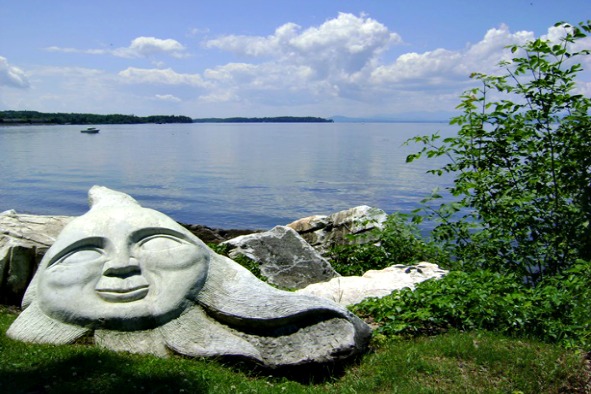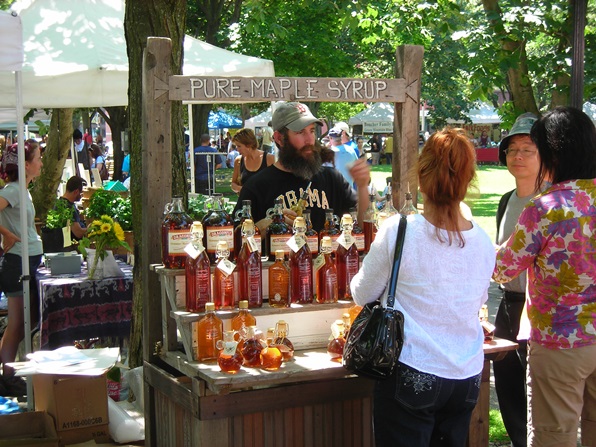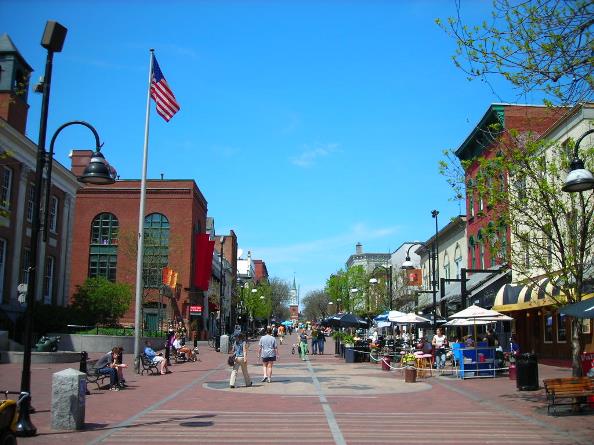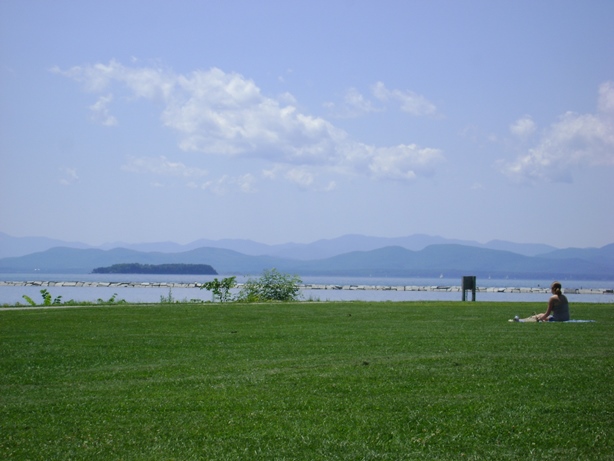The home of Bernie Sanders, Ben & Jerry’s, and Phish may be more accustomed to snow and ice but finds maximum chill in the summer months, when the temperatures rise and population drops.

Lake Champlain (Photo: Mike Dunphy)
In Vermont, we earn our summer. With snow potentially in the forecast six months of the year, the short, hot season between June and August is nothing to take for granted. At its worst, the heavy humidity makes peeling yourself off sticky garden furniture an added challenge to standing up, but at its best, the state’s rolling green rolling mountains and hills become as idyllic as Tolkien’s Hobbiton, with valley hamlets of stocky, hairy, and stouthearted folk, who relish a good pint of ale and dabble of pipe-weed.
It’s no different in Burlington, Vermont’s largest city (a whopping 50,000 people) and state capital in all things but politics. Swapping its 17,000-strong student population (who return home for the summer) from the three area colleges for tourists from Canada, Massachusetts, and New York, Burlington nonetheless enters its most languid phase of the year. Weekends see the downtown area and parks busier than ever, but in the neighborhoods surrounding, the mix of Victorian and Queen Anne style apartment buildings become a virtual ghost town.
Returning home at the start of June to enjoy the tranquility, I made my annual trip to the main campus of my alma mater, the University of Vermont at the top of College Street for my favorite view of Burlington. Facing west from the top of a fire escape, I see Burlington’s spiritual and temporal raison d’etre, Lake Champlain, stretch along the horizon. Named for the famous French explorer (and local legend) Samuel de Champlain who supposedly noted the verd mont on a map as he sailed along, which 200 years later became Vermont. The 13th largest lake in North America, Champlain not only dominates the city and landscape, it’s responsible for Burlington’s first fortune in the 19th century, when the north-south channel became a major shipping highway for lumber, stone, and agriculture.
This afternoon, it merely blows heavy, wet air across my face that balances the brightening sun with reminders of the freeze just a few months before. It’s a quality that draws me, and other Burlingtonians lakeside this afternoon in late May, as an early bout of 80-degree temperature heats up bodies and metabolisms more suited to ice and snow. Indeed, from the panoramic bulge at the center of the boardwalk of Waterfront Park, I can see windsurfers, kayakers, and yachts already taking advantage of the unusual warmth, while the first canopy tents of the many festivals to come—jazz, food, beer, dragon boats, and more—begin to raise on the broad lawns to my right.

Maple syrup for sale at the Burlington Farmer’s Market (Photo: Mike Dunphy)
Behind me, Burlington’s greatest man-made attraction, the Burlington Bike Path, threads the waterfront area, extending 10 miles altogether on top of the former railroad lines. To experience all of it, I rent a bike at nearby North Star Sports and plop down $25 for the four-hour rental, which is enough time to make it up to the northern causeway that goes onto the lake itself. The terrain changes to gravel here, requiring additional effort (and sweat) to pass through. However, with so much gorgeous lake and mountain scenery, I hardly noticed, and when I did, the views provide as ideal an excuse I could ever want to dismount and catch my breath.
Alas, I was not able to catch sight of the fabled Champlain sea monster, Champ, break the surface of the water and give me the best selfie ever.
Leaning back on one of the blasted rocks forming the bike path bank and closing my eyes, the observation of Burlington by an old girlfriend rang true once more—“every day here is Sunday.” Indeed, there’s probably no truer insight into the Burlington state of mind, the same elected Bernie Sanders to the mayorship for eight years during the 1980s (ages 6—14 in this writer’s calendar) and bore both Ben & Jerry’s and Phish. It’s rush hour that’s the aberration.

Church Street marketplace (Photo: Mike Dunphy)
The exception in summer is the Church Street Marketplace, around which the city’s cultural and commercial life revolves. Returning there late afternoon, I join the hundreds of other tourists and locals spilling out from the four pedestrianized blocks that start at the colonial red-brick, white-steeple Unitarian church built in 1816. From there, the street proceeds south past fashion boutiques, bookstores, and gift shops to restaurants, bars, headshops, and other sinful pleasures (Lake Champlain chocolates, I’m looking at you). The last block, boarded by Main Street, forms the hub of nightlife with live music, dancing, and a serious pedigree of craft beer. Spying an empty table on the outdoor patio of one bar, I sip a well-earned beer and turkey club while watching the world amble slowly by—a true Burlington moment.
Heading up the slope east of downtown afterwards to explore the handsome brick, wood, and stone manors built in the 19th-century by Burlington’s lumber, shipping, and banking barons along South Willard, Union, and Williams streets, I realize I probably should have waited on the beer. To do a full tour requires a certain degree of athletic fitness and good walking shoes, but the burn in my belly and cardiac palpitations are proof of how the geography helps make it as one of the healthiest cities in the country.

Admiring the hills at Waterfront Park (Photo: Mike Dunphy)
The Burlington of the future, however, is largely growing south of downtown, particularly in the former industrial zone of the South End. Poking around the former factories, machine shops, and warehouse, I discover a menagerie of art studios, galleries, art supply stores, custom framers, and brewers—each worthy of a visit. It’s here the annual Art Hop, Burlington’s largest annual arts festival, symbolically ends the summer each September with three days of exhibitions, food trucks, live music, and events.
Having attended the festival several times in the past, I remember once more why the sense of community is so strong in the city. Burlington thrives because its inhabitants work hard to make it that way, and its sunny disposition is as much because of warm weather as civic pride. It’s in summer, when the boughs blossom Vermont verd and the lake turns its bluest blue, that both Burlington and I remember why the sometimes frosty relationship is worth all the effort—and why it might indeed be time to move home.